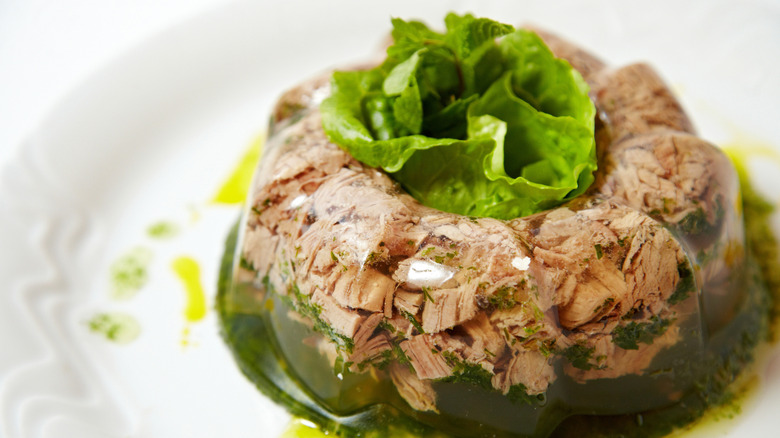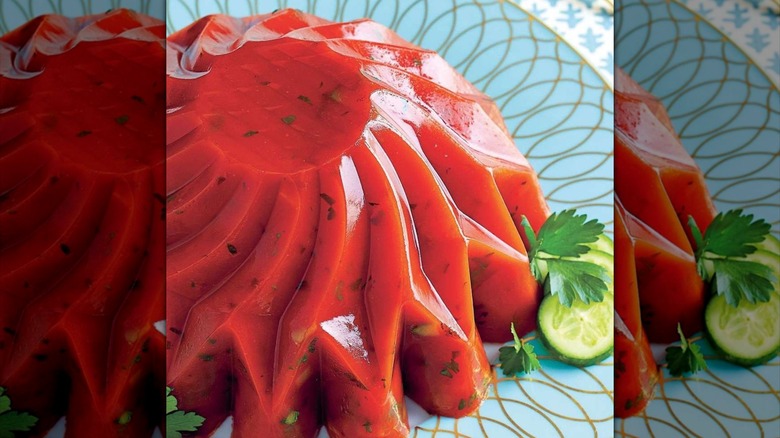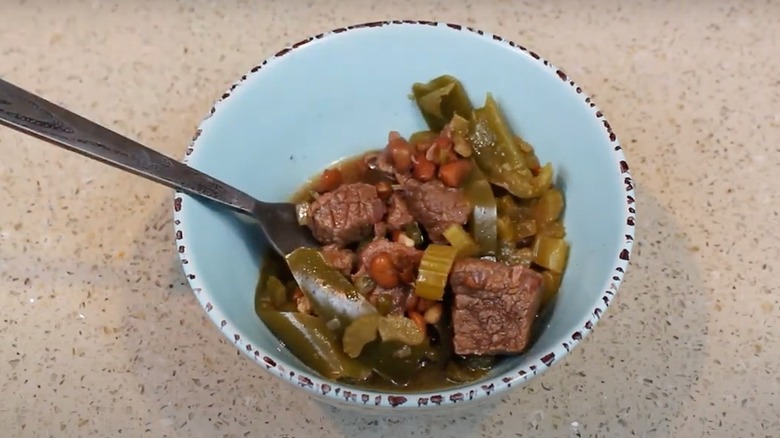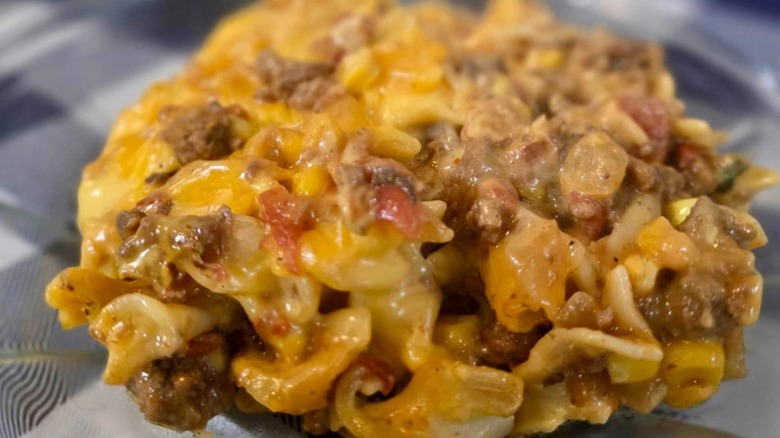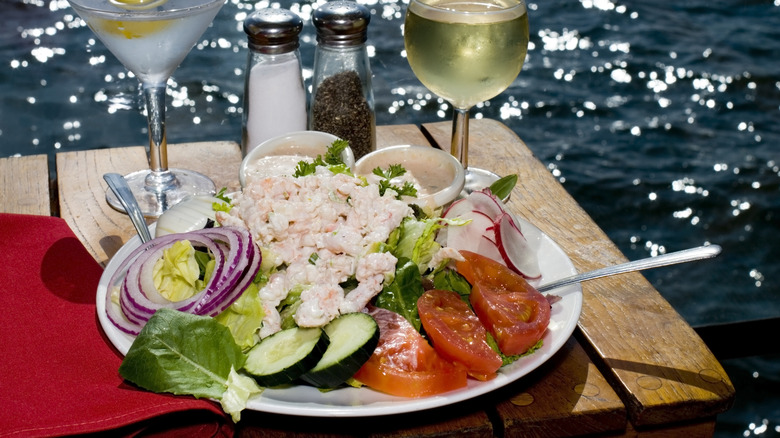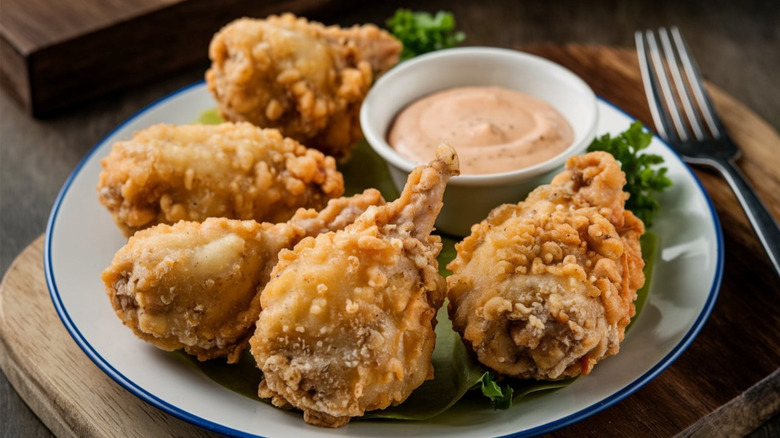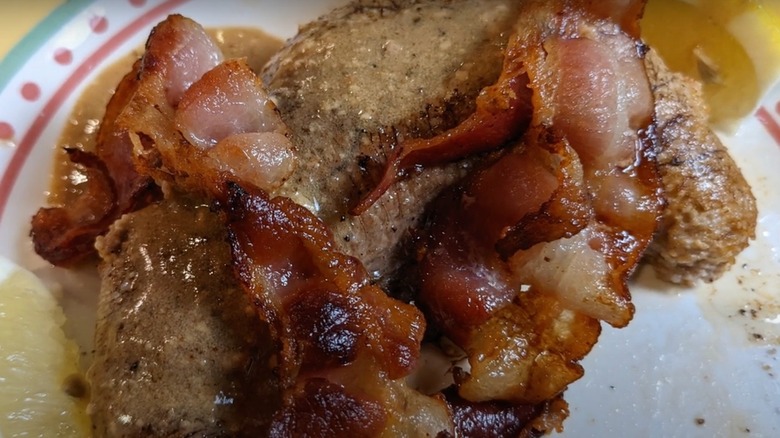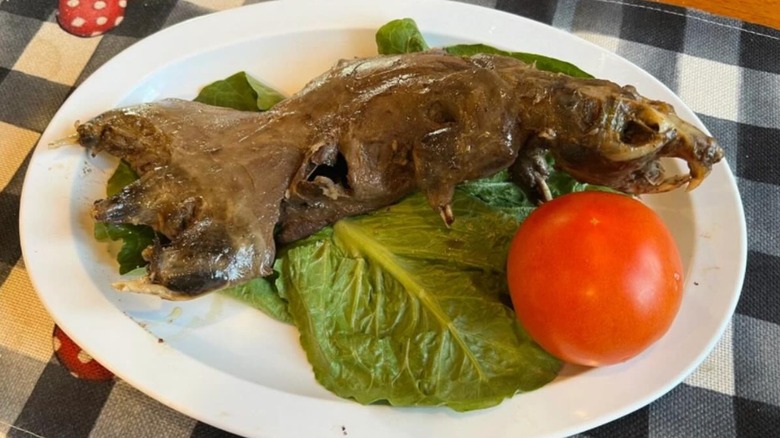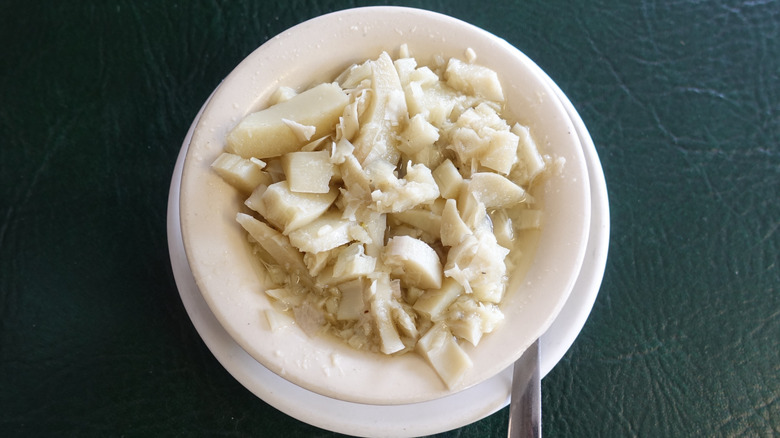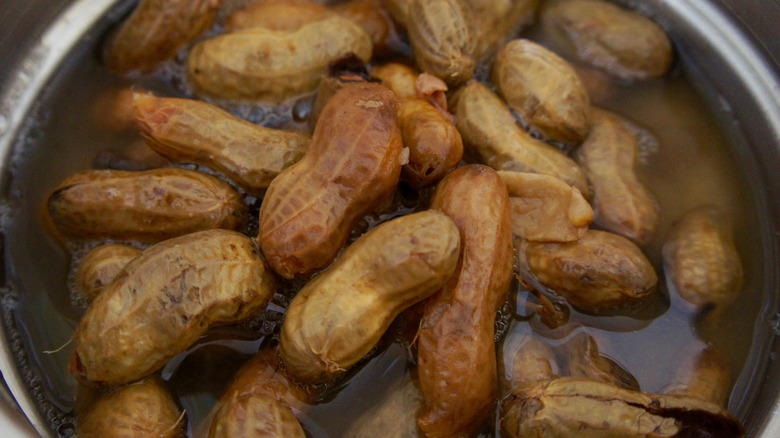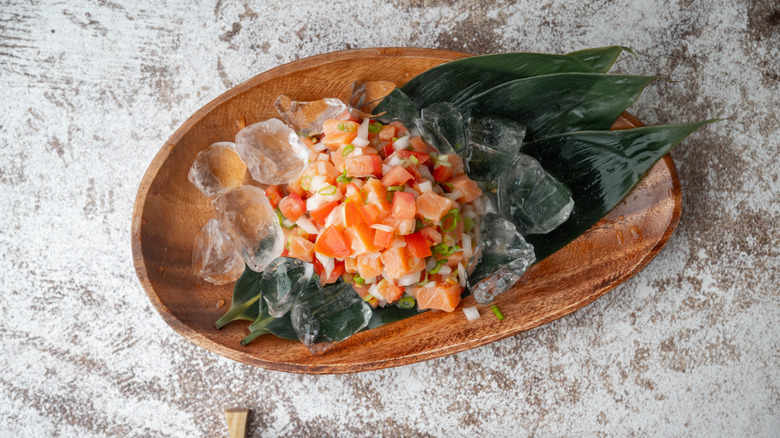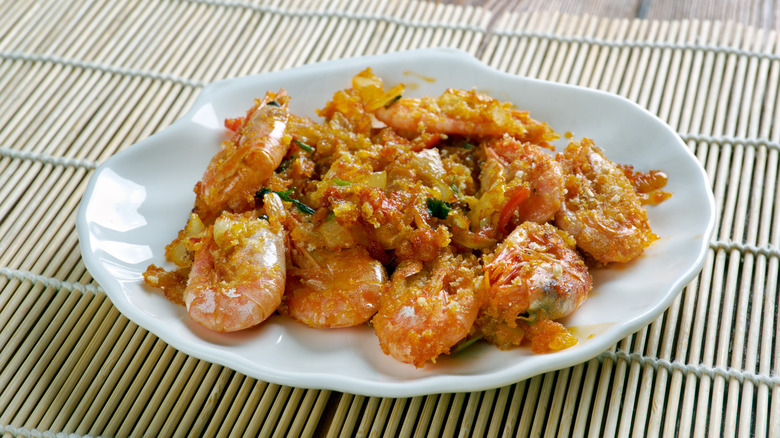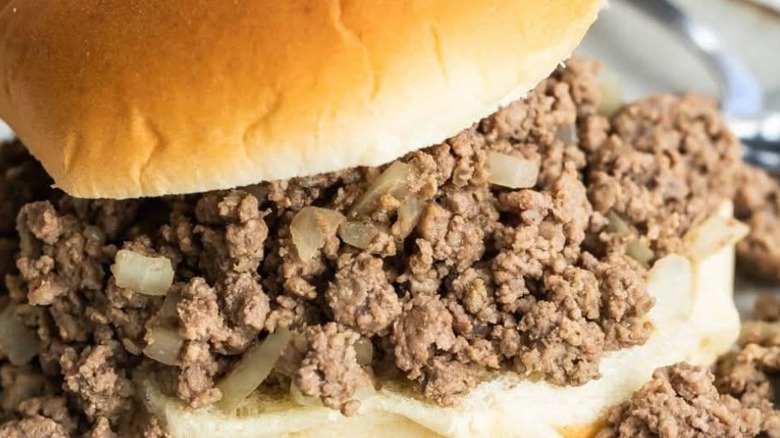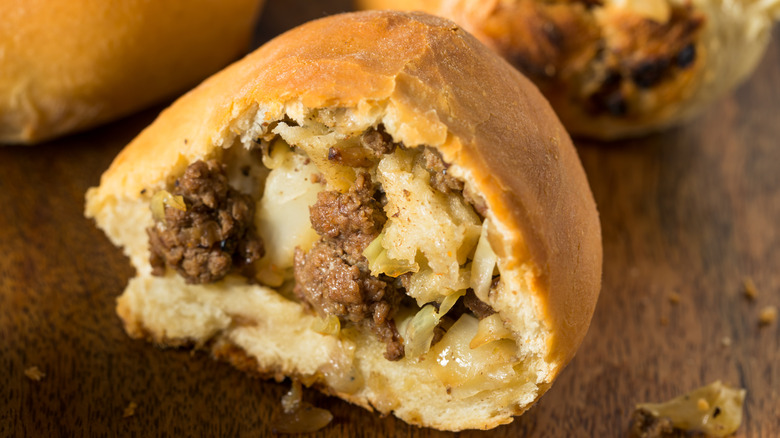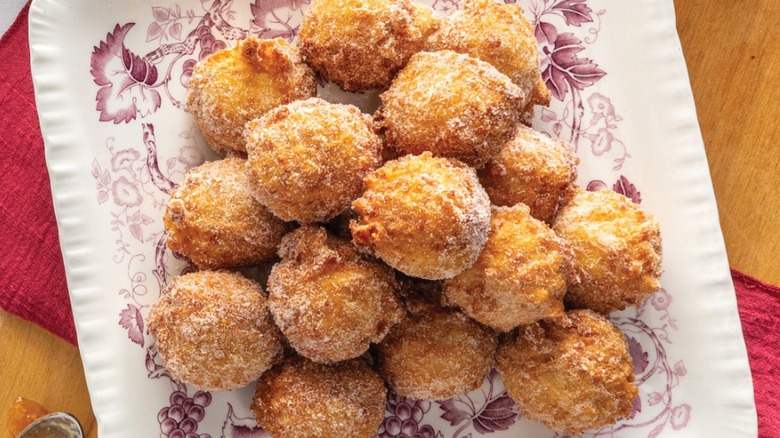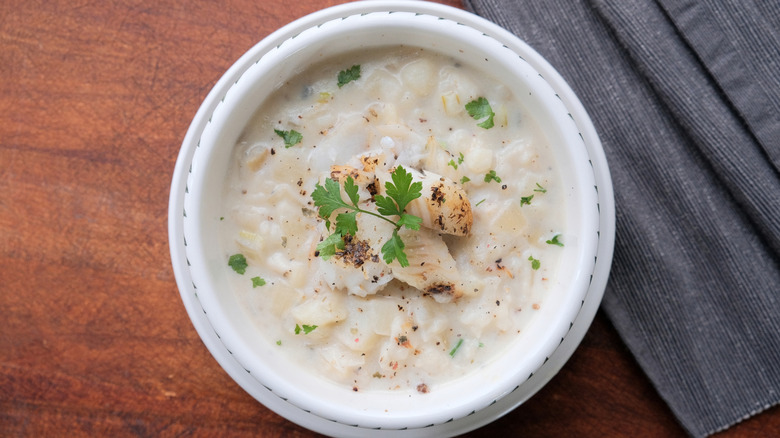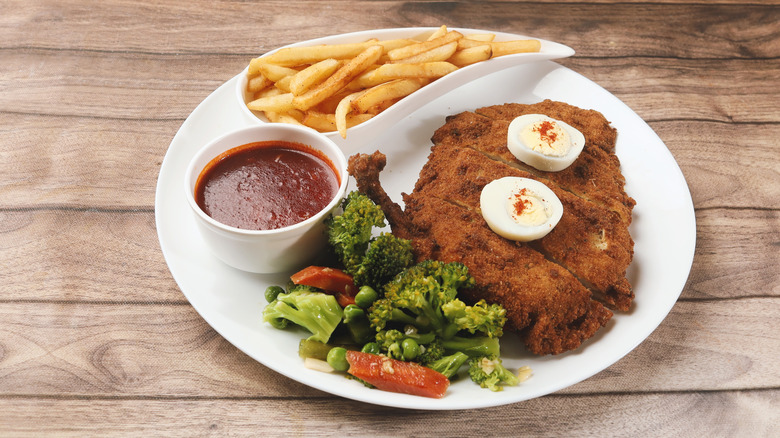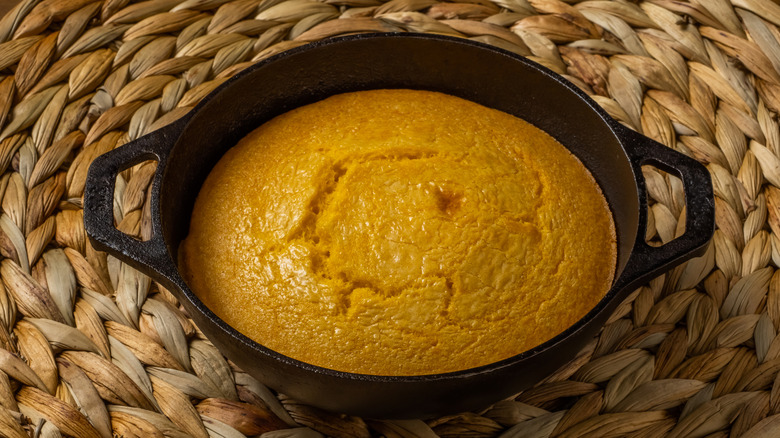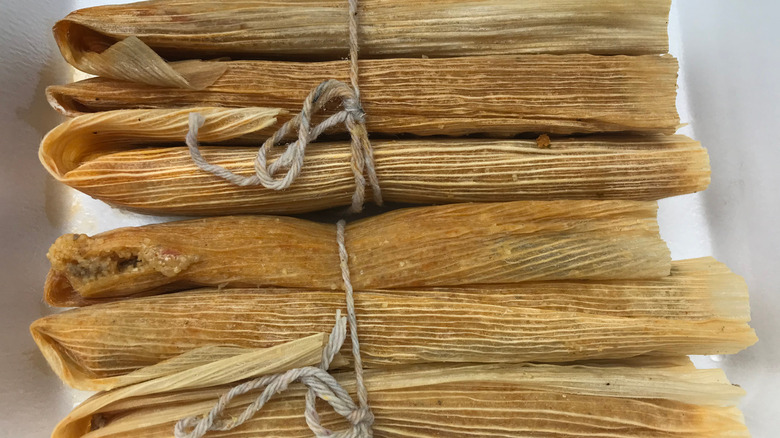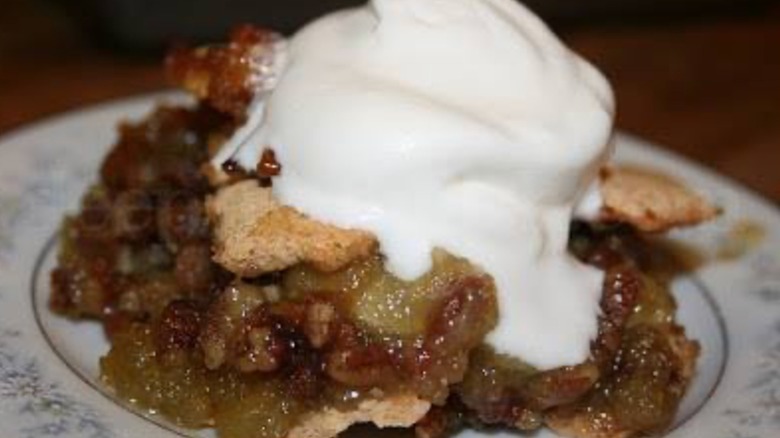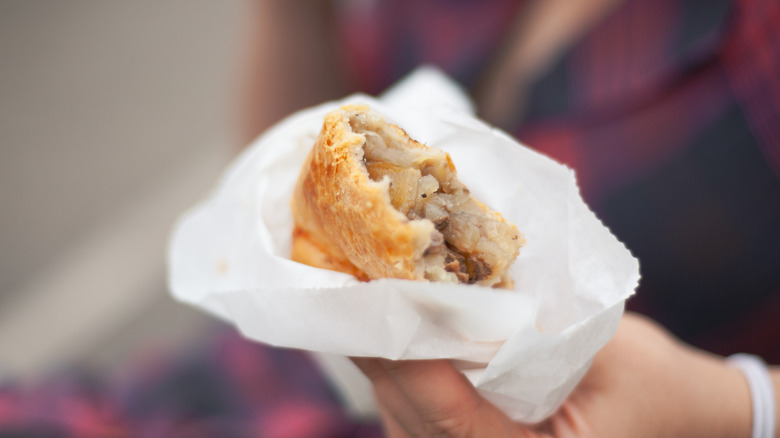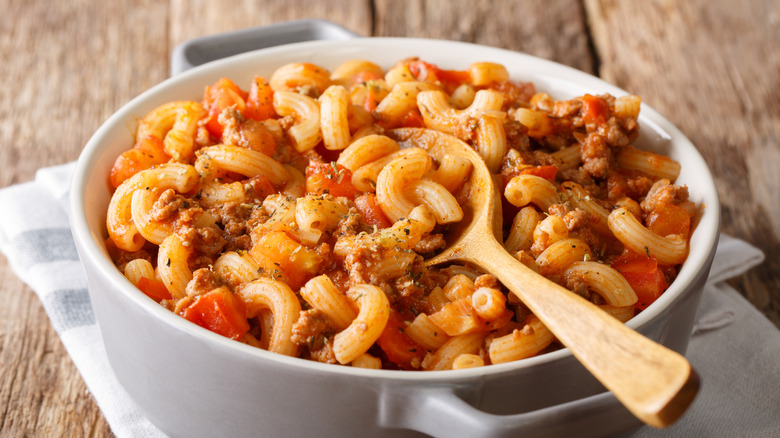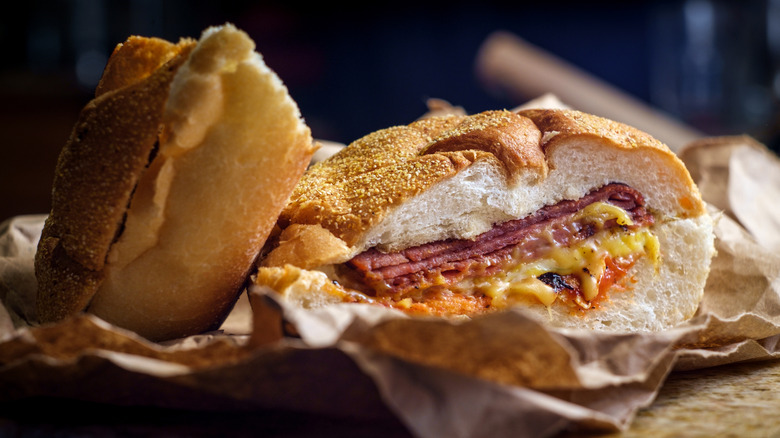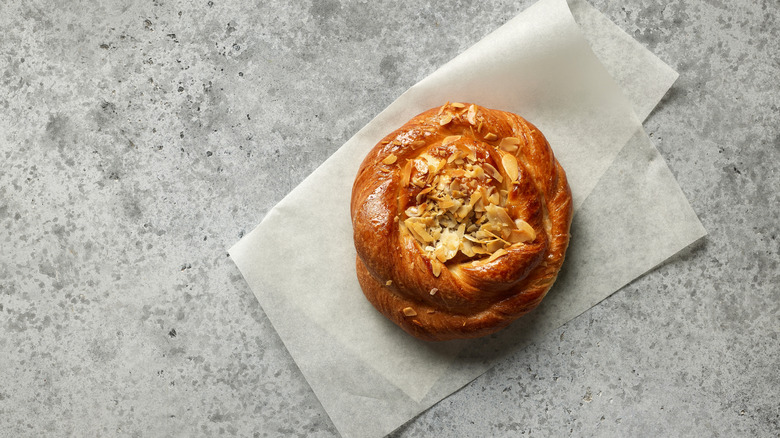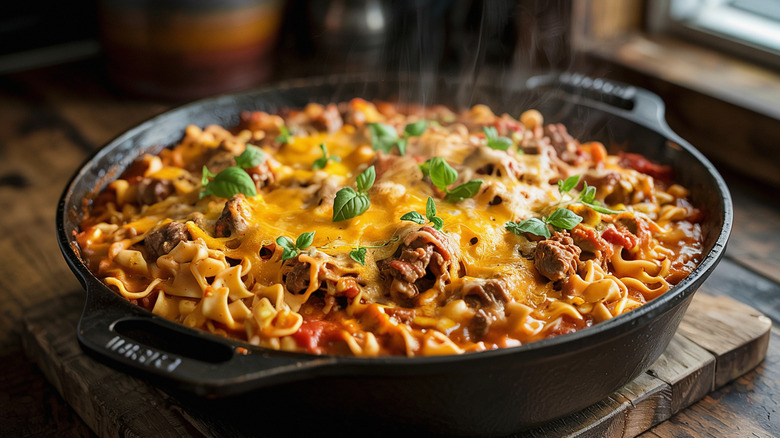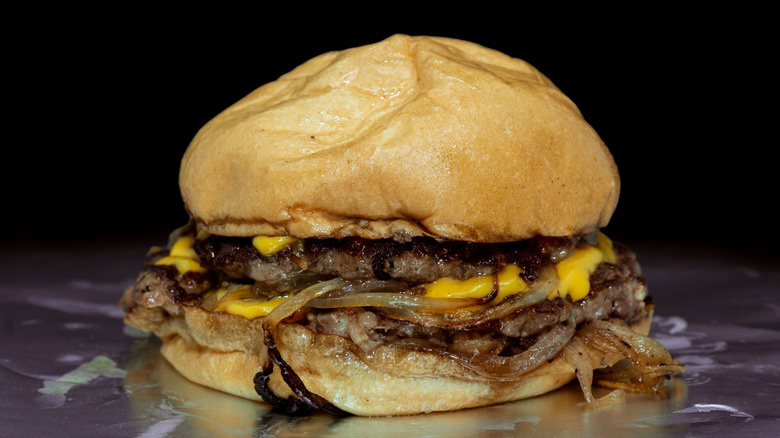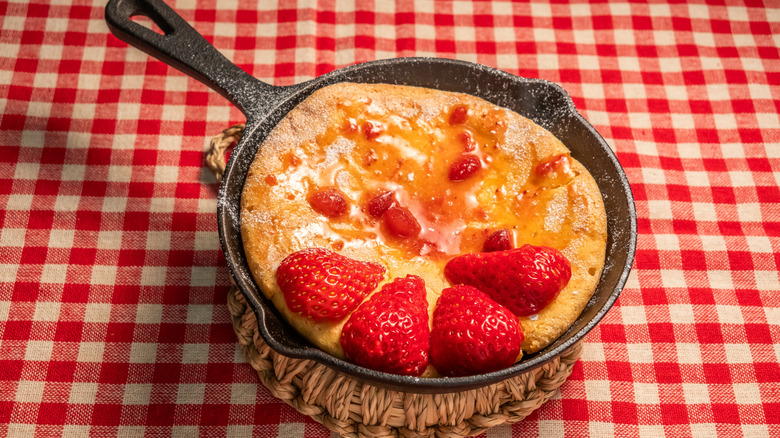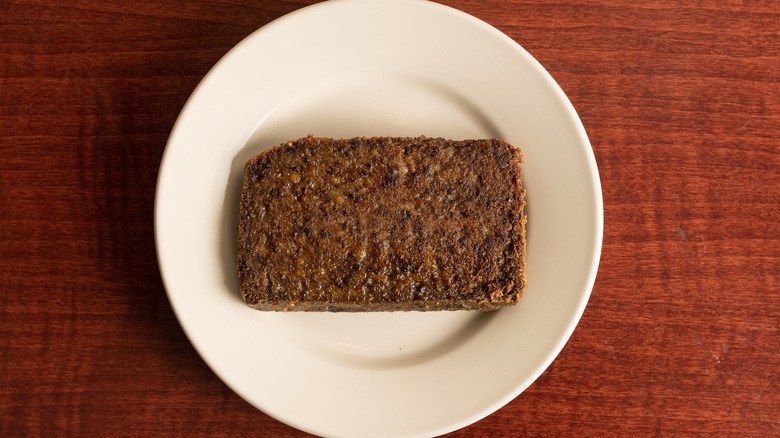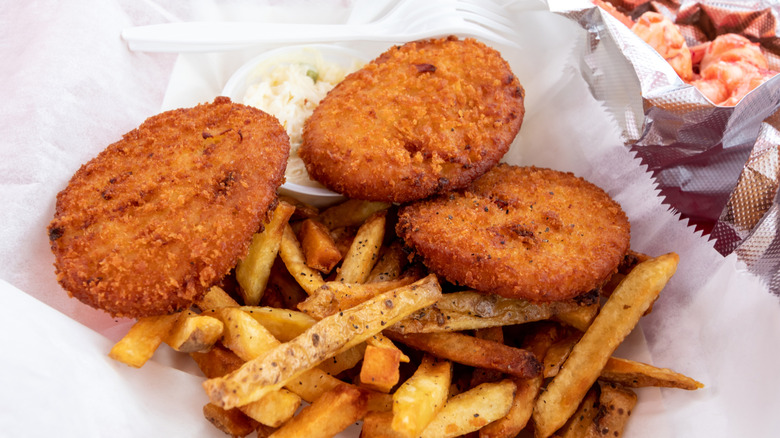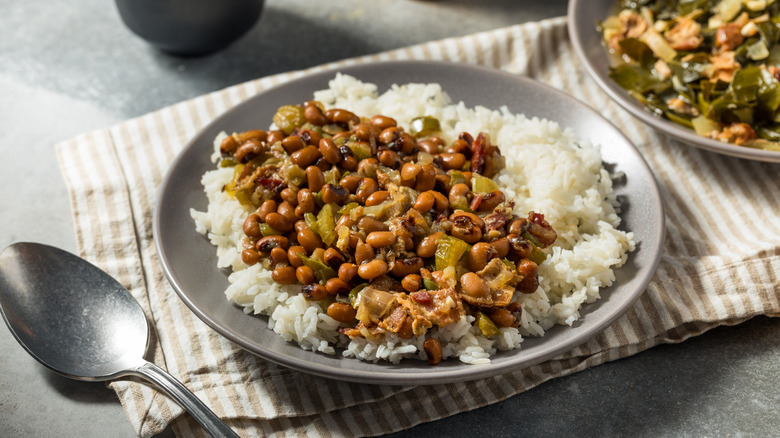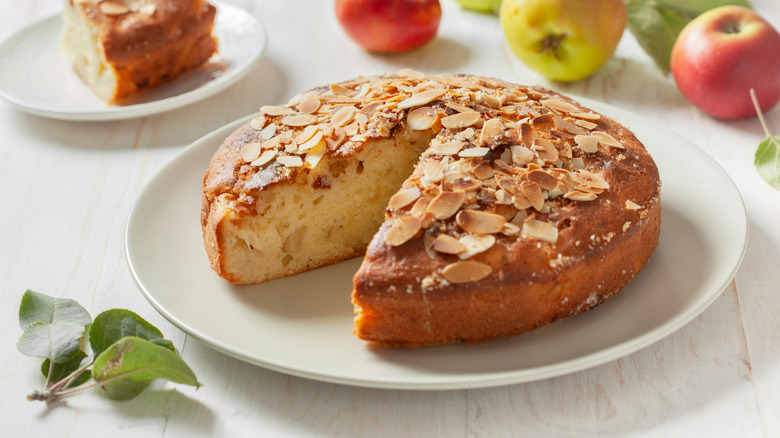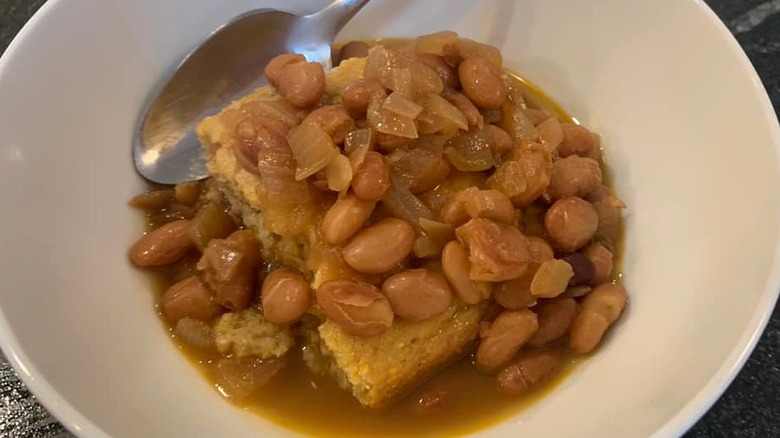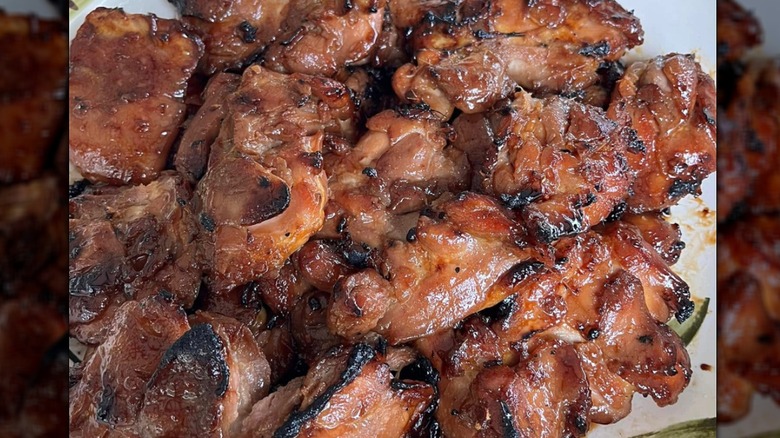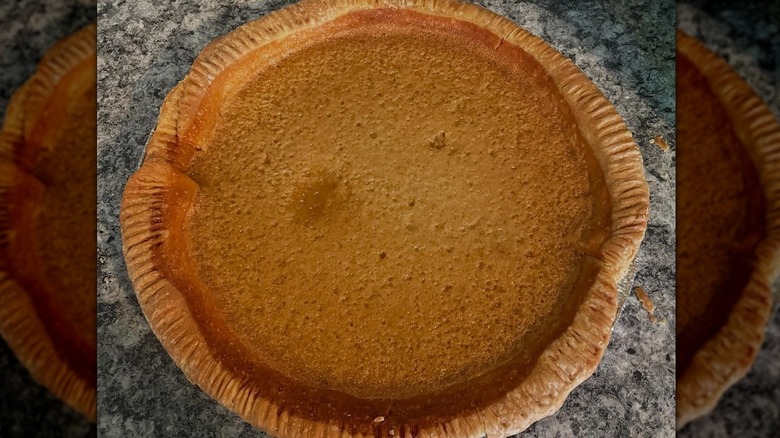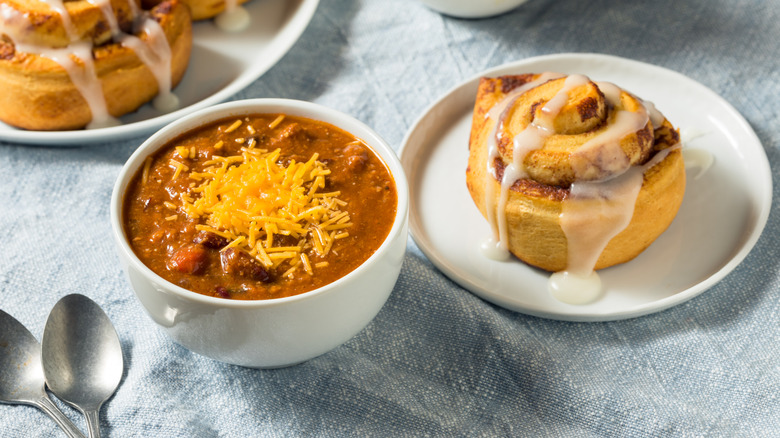Mostly Forgotten Retro Dishes From Every US State
Whether you call them vintage, nostalgic, old-fashioned, or retro, some dishes haven't withstood the test of time. Many were born out of necessity, like those that emerged during the Depression-era, while others were a product of fads that came and went as quickly as you can blink, like the many gelatin-based dishes that were popular during the 1960s and 1970s.
Though some old-timey recipes were equally as favored across the country, others were unique to the states within which they emerged. They acted as a kind of edible microscope through which you could understand a particular region or the people that lived within that state.
Many of these recipes are remnants of a bygone era, but some of these retro foods deserve to make a comeback. From fancy appetizers and desserts to potentially stomach-churning meat dishes, read on to discover the mostly forgotten vintage dishes from every U.S. state and how they came to be.
Alabama: Tomato Aspic
Though aspics may seem like something you're more likely to experience at a fancy French restaurant, gelatin-based salads of all ilks became a staple of households across America during the 1950s and '60s. One that was quintessentially Alabaman was tomato aspic, as it was served during lots of formal gatherings throughout the state's history.
This jiggly concoction that resembled a Bloody Mary in JELL-O delivery format was a staple during holiday meals. It was frequently prepared in wreath-shaped molds and garnished with copious quantities of mayonnaise and a sprig of parsley.
Alaska: Jellied Moose Nose
While jellied moose nose may not be a conventional dish in the lower 48, it's a rare delicacy that has long featured in the diets of Alaskan and Canadian Indigenous communities. Moose is considered necessary for subsistence in Alaska and every inch of the animal is invaluable, including its substantial snout.
Jellied moose nose is similar to head cheese or a French terrine. It's prepared by cooking the nose meat with spices, forming these into a loaf pan, and allowing them to chill until firm.
Arizona: Tepary Bean Stew
For thousands of years the Indigenous peoples of the Tohono O'odham Nation of the Sonoran desert of Southern Arizona have relied on tepary beans to subsist. This drought-resistant bean is uniquely adapted to the dry climate of this region, but is extremely laborious to cultivate, leading to its extinction in the 1970s.
While these nutritious beans can be made into a number of recipes, tepary beans are often fashioned into a rich stew. It features chopped vegetables, aromatic spices, and, occasionally, meat, which are slow-cooked with the delicate beans until tender.
Arkansas: Tallerine
Much of the culinary history of the people of Arkansas can be viewed through the lens of the church cookbook. Many of these feature recipes for something akin to a predecessor of Hamburger Helper, namely tallerine.
Tallerine is a regional specialty that made an appearance at any potluck in the state of Arkansas up until the late 1980s. This casserole features ground hamburger, egg noodles, Velveeta cheese, and canned black olive slices.
California: Crab Louie
Among the notable American menu classics that have almost disappeared is crab Louie. Often dubbed the "King of Salads," it emerged on the West Coast of the United States in the early 20th century. It was popularized by the Palace Hotel in San Francisco, California, making it an iconic dish of the state.
This salad is generally composed of iceberg lettuce, Dungeness crab meat, tomatoes, cucumbers, hard-boiled eggs, and lemon wedges served with a creamy dressing. The distinctive dressing features mayonnaise, Worcestershire sauce, lemon juice, chili sauce, and green peppers.
Colorado: Rocky Mountain Oysters
When it comes to foods that aren't what they sound like, Rocky Mountain oysters might be king. In fact, this dish doesn't feature shellfish at all. The "oysters" in this case refer to bull testicles.
This Coloradan delicacy is a relic of the "Old West," when cowboys regularly castrated cattle, leaving them with an abundance of beef testicles. These testicles were lightly battered and pan-fried until crispy. While no longer as popular as they once were, they can still be found in dive bars across the state.
Connecticut: Shad Roe with Bacon
The state fish of Connecticut, shad has been a staple of the diets of Indigenous peoples residing in the region. Though its consumption has declined notably with the dwindling shad population, it is still seen as a delicacy enjoyed on special occasions.
Because shad fish are punctuated by hundreds of tiny bones, the meat is challenging to prepare, which is why its roe is the real prize. Shad roe is historically cooked in butter and adorned with crispy bacon.
Delaware: Barbecued Muskrat
A unique relic of Delawarean history is muskrat trapping. Its fur used to be a valuable commodity, with thousands fetched from the marshes around the Delaware Bay every winter. Though the fur no longer brings in the big bucks, the muskrat is still a local delicacy of the Delmarva Peninsula, albeit a rare one.
Muskrat is often barbecued whole. Its flavor is deemed "brackish" and "swamp-like," while its texture is lean and sinewy.
Florida: Swamp Cabbage Stew
A Floridian culinary relic is swamp cabbage stew. This concoction features a native plant, known as the sabal or cabbage palm. This type of palm has been used for centuries by Indigenous communities. Early pioneers learned how to process the sabal palm and turn it into a stew.
It has fallen out of favor because harvesting this type of palm is labor-intensive and necessitates killing the tree. That said, a few communities continue the tradition, with a Swamp Cabbage Festival still being held in LaBelle, Florida annually.
Georgia: Boiled Peanuts
Boiled peanuts are a Southern institution and Georgian delicacy. The process of boiling green peanuts began there during the Civil War, when Confederate troops were running short on rations and needed a portable source of protein.
Though recipes for boiled peanuts vary, most include salt, which acts as a preservative. Roadside stands in Georgia still sell boiled peanuts, though they are rare.
Hawaii: Lomi Lomi Salmon
While lomi lomi salmon is considered quintessentially Hawaiian, occasionally appearing at luaus and holiday meals, it's less well-known than poké or Spam musubi. This dish is said to have emerged during the 18th century, when migrant Hawaiian workers made their way to the Pacific Northwest where they discovered salmon.
The term "lomi" translates to "rub" or "massage," which is the process by which the salmon is cured with salt. This salmon is combined with tomatoes and onions and allowed to marinate before serving.
Idaho: Huckleberry Roly Poly
Each year, from the end of July to early August, locals and tourists flock to the mountains of Northern Idaho to pick huckleberries. One recipe that some who grew up in this region recall from childhood is a classic British pudding called a roly poly.
A traditional roly poly is prepared by rolling out biscuit-like dough made with suet, filling it with jam, and steaming it. Few people make the authentic recipe anymore, but the real deal, prepared with freshly-made huckleberry jam, is an Idaho legacy.
Illinois: Shrimp DeJonghe
Shrimp DeJonghe is a classic dish invented at the famed DeJonghe Hotel of Chicago in the late 1800s. While rumor has it the dish was created by one of three Belgian brothers (Henri), who owned the hotel, some believe it was attributable to resident chef Emil Zehr.
The recipe consists of shrimp coated in a mixture of butter, copious amounts of garlic, sherry, parsley, and breadcrumbs before baking until golden. Once a staple at many of Chicago's finest dining establishments this recipe has become a novelty.
Indiana: Persimmon Pudding
Persimmons are indigenous to Indiana. These ping pong-sized sour fruits have been a treasured part of autumnal celebrations in the state. One recipe holds a soft spot in the hearts of Hoosiers: persimmon pudding.
This pudding is like a cross between a custard-like pie and gingerbread. Dark, lip-puckering, and sticky, it's historically served with a dollop of whipping cream. Today, you likely will only find it being served at the annual Mitchell Persimmon Festival.
Iowa: Maid-Rite Sandwich
Whether you call it a loose meat sandwich or Maid-Rite sandwich, it's an Iowan invention. This combination of seasoned ground beef packed on a pillowy bun, then topped with onions, pickles, and mustard, was invented in 1926 by a butcher from Muscatine, Iowa named Fred Angell.
When he served the sandwich, his clientele exclaimed that it was "made right," hence the name. The sandwich became so popular that it led to a franchise, which still exists today, though these are nowhere near as popular as they once were.
Kansas: Bierocks
Bierocks are a legacy of mostly German Russian Mennonites who came from Eastern Europe and settled in Kansas in the 1870s, where they have been prepared the same way ever since. These precursors to the modern-day hot pocket were invented as a portable, yet healthy, meal for working men.
They consist of a flaky pastry crust filled with beef, onions, and cabbage or sauerkraut. Bierocks resemble Nebraska runzas, but are shaped differently, with the former being round and the latter being rectangular.
Kentucky: Burgoo
Burgoo is more than just a recipe, it's a dish that defines the traditions and culture of the people of Kentucky. For generations it was the centerpiece of social gatherings.
This stew that slowly cooks over an open fire in a cast iron pot generally contains three types of meat, vegetables, beans, and potatoes, though these vary seasonally. While you may find a pot of burgoo boiling during the Kentucky Derby, it's a less common fixture in the daily lives of Kentuckians.
Louisiana: Calas
Golden rice fritters that are a legacy of New Orleans, calas have all but been forgotten. Made from leftover rice that has been added to a doughnut-like yeast dough, calas used to be sold on every street corner by ladies yelling, "Calas, belles calas, tout chauds!"
These fritters are thought to have come to America along with enslaved Africans. During the late 1700s, many enslaved women were able to buy their freedom from Spanish rule through the sale of calas.
Maine: Haddock Chowder
While there are many different types of chowder, a popular recipe in Maine is made from haddock. This delicate, flaky fish has been a staple of the diets of New Englanders. Haddock chowder should be milky, but not gluey, and this is non-negotiable.
Despite the fact that fish chowder continues to be beloved, haddock has become increasingly harder to come by. Overfishing has resulted in a serious decline of the haddock population in the Gulf of Maine, making this dish a rarity.
Maryland: Maryland Fried Chicken
Fried chicken may not seem particularly fancy, but chicken à la Maryland or Maryland fried chicken was a dish worthy of first class. This relic of Maryland households from the late 1800s was served aboard the RMS Titanic on the day it sank on April 14, 1912.
What puts Maryland fried chicken in a class of its own is its preparation. The meat is breaded, then pan-fried. The drippings from the chicken are subsequently transformed into a luxurious white gravy.
Massachusetts: Spider Cake
The term "spider" refers to a cast iron skillet with legs that could be rested above coals in a hearth. The first known recipe appeared in the 1832 "American Frugal Housewife" cookbook under the name "Indian Cake," which referred to the key ingredient cornmeal, which was called "Indian meal" — as corn was a staple of Native American diets in Massachusetts.
The base of this cake resembles a classic cornbread recipe, but is much sweeter and moister. Heavy cream is drizzled into the prepared dough before baking, which provides a distinctive custard-like texture.
Michigan: City Chicken
If you grew up in Detroit or its suburbs, chances are you may have enjoyed this dish. City chicken is a relic of the Polish-American community that occupied major metropolitan areas of the Midwest during the Great Depression.
At that time, poultry was considered to be a luxury item. Cubes of meat were breaded, deep-fried, and baked to resemble fried chicken. These were often served with a gravy to reinforce the mock chicken vibe.
Minnesota: Glorified Rice
If you've ever experienced glorified rice, you have the Scandinavian Lutheran community of Minnesota to thank. This dish, which was popular at virtually every holiday gathering in the state, reflects the sensibilities of immigrants from Scandinavia and pays homage to the culinary traditions of the Ojibwe people, who inhabited the region and subsisted on rice.
This dish features cooked rice combined with canned fruit (typically pineapples), marshmallows, and Cool Whip. Some Redditors recall enjoying variations of it as kids that contained maraschino cherries, fruit cocktail, or chopped nuts.
Mississippi: Delta Tamales
The history of how tamales came to be a staple of the Mississippi Delta is unclear. Some believe it to be a relic of the Mexican-American War, while others point to the co-mingling of Mexican and Black laborers in cotton fields a century later.
What sets them apart is their cigar-like shape, a filling made from cornmeal and not masa, and their spiciness. Though they still hold a special place in the hearts of those residing in the Delta, they are slowly vanishing as fewer people learn to make them from-scratch.
Missouri: Ozark Pudding
Ozark pudding is generally attributed to first lady Bess Truman. She popularized it in the 1950s when serving it to her husband, then president, Harry Truman, at the White House.
This dish showcases everything that makes the Ozarks of Missouri so special. It features diced apples and nuts baked into a custard-like cake until light and fluffy. It is typically served warm, scooped into a bowl and topped with freshly whipped cream.
Montana: Pasty
While pasties didn't originate in Montana, they became popular in the town of Butte in the late 1800s. At this time, Cornish and Irish immigrants fled to the region to work the copper mines, bringing with them the pasty.
This handheld pie typically features cubes of beef, potatoes, and onions tucked into a flaky pastry crust. Though you can still find them in Butte, assembling them is an art form requiring an expert hand that fewer are taking the time to master.
Nebraska: Runza Casserole
While Kansans have the bierock, Nebraskans have the runza. Though individual runzas are very time-consuming to make, disassembling the recipe into a one-dish wonder is something home cooks can easily replicate. The runza casserole or bake is something many Redditors recall with nostalgia from childhood.
The casserole typically features a flaky pastry crust, ground beef, sauerkraut, cheese, onions, and a can of cream of mushroom soup. More modern iterations may use canned crescent rolls and coleslaw mix, but the real deal is made with homemade pastry.
Nevada: Shrimp Cocktail
Traditional shrimp cocktail served in a 6-ounce tulip glass with a spicy cocktail sauce for 99 cents is considered a retro dish. Though variations of this dish are served at many restaurants, the original iteration is a thing of the past.
The classic shrimp cocktail was invented in 1959 by Italo Ghelfi at the Golden Gate Hotel and Casino in Las Vegas, Nevada. It was considered to be the most popular appetizer in the United States until the late 1980s, after which it became something of a novelty.
New Hampshire: American Chop Suey
When you think of chop suey, you may think of an American Chinese dish. American chop suey is a completely different beast. According to many Redditors who grew up eating it, while similar dishes exist elsewhere in America, under names like goulash, slumgummy, and hot dish, in New Hampshire it is called American chop suey.
The recipe is a stew-like dish made with ground beef, onions, bell peppers, spices, and tomatoes combined with pasta. It's a rustic dish that was often made for a large crowd.
New Jersey: Taylor Ham Sandwich
Though a Taylor Ham sandwich may not be entirely a thing of the past, fewer people are consuming them. Taylor Ham or Pork Roll, as it is sometimes known, is an integral part of New Jersey culinary history.
Invented in Trenton, New Jersey in 1856 by John Taylor, this circular loaf of smoked pork cured with salt, spices, and preservatives is most frequently enjoyed at breakfast. It is typically fried, topped with eggs and cheese, and encased in a bagel or a hard roll.
New Mexico: Stacked Enchiladas
While enchiladas are a popular item at Mexican restaurants, the stacked variety are quintessentially New Mexican. It brings back fond memories of childhood for many who grew up in the state, with one Redditor saying, "Reminds me of Saturday nights when I was growing up when my mom would make these."
The recipe is quite basic. Fried corn tortillas are layered alternating with a spicy red or green enchilada sauce, shredded lettuce, tomatoes, and cheese. The whole dish is topped with a fried egg.
New York: Nesselrode Pie
If you ever watched "The Andy Griffith Show," you may recall Aunt Bee baking a quirky pie made from chestnut purée and candied fruit soaked in rum or brandy. This dessert is called Nesselrode pie and it was all the rage in New York City from the 1940s through the 1960s.
The pie originated as a spin on a pudding recipe named for a 19th century Russian count. A recipe for it was featured in The New York Times in 1945, after which it became a fixture on the menus of restaurants across the city.
North Carolina: Sonker
The sonker is a vintage recipe that has murky origins. It hails from a very specific region near the foothills of the Blue Ridge Mountains of North Carolina in Surry County, where it is still prepared by a handful of bakers along what is known as the Surry Sonker Trail.
The base of this recipe is fruit layered into a casserole and topped with a pancake-like batter. The result is something resembling a cross between a cobbler and a pie.
North Dakota: Dakota Rolls
Dakota rolls or caramel (pronounced "car-mull") rolls are a delicacy of North Dakota. One Redditor guards the family secret fiercely stating, "You'll never get my recipe as long as I carry breath in this mortal coil." Not to be confused with a sticky bun or a cinnamon bun, these fluffy rolls are drenched in luscious caramel.
As to who invented it, most believe it's a remnant of Scandinavian and German Russian immigrants. Earliest recipes date back to the 1920s, where they became popular until the 1970s.
Ohio: Johnny Marzetti Casserole
Anyone who attended grade school in Columbus, Ohio in the mid-to-late 20th century likely consumed a Johnny Marzetti in the school cafeteria. This noodle dish is a mixture of ground beef, tomatoes, onions, cheese, and macaroni.
Many attribute the invention of the Johnny Marzetti to a chain of restaurants established by Teresa Piancentini Marzetti in 1896, though this contested. Regardless of its precise origins, this recipe is seldom found in mainstream settings today.
Oklahoma: Oklahoma Onion Burger
The idea of the Oklahoma onion burger seems quaint in a world of supersized meals. This Depression-era specialty represents the ingenuity of Oklahomans during a period of scarcity.
Invented by Homer and Ross Davis at their Hamburger Inn in El Reno, Oklahoma in the 1920s, this burger is something of a precursor to the smashburger. It features a scant amount of ground beef, which was expensive during the Great Depression, melded together with tons of caramelized onions before being placed onto a steamed bun.
Oregon: German Pancake
For those who grew up in Portland, Oregon anywhere from 1932 to 1990, the German or Dutch baby pancake was considered a Sunday brunch fixture. It was a favorite menu item at the popular Henry Thiele's Restaurant.
Many have unsuccessfully attempted to recreate the recipe since the restaurants closure. The outsized pancake was characterized by its fluffy texture and simplicity. It was best served with a dash of melted butter, squirt of lemon juice, and a dusting of powdered sugar.
Pennsylvania: Scrapple
A specialty of the Pennsylvania Dutch, scrapple is a nostalgic food that has been around since German colonists settled in America during the 17th and 18th centuries. Though an acquired taste, this dish is the perfect example of a waste-not, want-not mentality.
It features the scraps of pig that would otherwise be discarded, including organ meats and skin. These are boiled together with cornmeal or flour, onions, and seasonings and formed into a loaf. It is most commonly served in slices that are fried up for breakfast.
Rhode Island: Clam Cakes
Clam cakes are a regional delicacy of Rhode Island that many recall eating at Warwick's Rocky Point Amusement Park, which operated from 1847-1995. Though clam cakes are still served by clam shacks along the state's shorelines, purists long for the original recipe, with one Redditor noting, "I can't remember one amusement ride ... but those clam cakes have haunted me for years!"
These clam cakes were more light, fluffy, and golden brown. They were heavy on the cake and modest on the clam.
South Carolina: Hoppin' John
While many are familiar with the tradition of eating black-eyed peas for luck on New Year's Day, fewer understand the history of the classic dish hoppin' John. It is classic Gullah cuisine, reflecting the history of enslaved Africans in the region of South Carolina during the mid-1800s.
Often called Carolina peas and rice, this stew combines the black-eyed peas with bacon, onions, and heavy seasonings. Though still consumed by some as a novelty at New Year's it is less frequently eaten on a regular basis.
South Dakota: Kuchen
Many would be surprised to discover that South Dakota was a hotspot for German migrants during the 1800s. These Germans settled here thanks to the Homestead Act of 1872, bringing with them their culinary traditions, including recipes for a classic kuchen or cake.
Though the recipes for kuchen are diverse, a majority of them are made from an enriched yeast dough laden with fresh fruit, often plums or apricots. This recipe is typically served with coffee and is a reminder of a bygone era.
Tennessee: Appalachian Soup Beans
Though perhaps not popular outside of the Appalachian mountain range region of Tennessee, as one Redditor said, "I think soup beans are the most Appalachian meal in existence." This combination of slow-cooked pinto beans, salt pork, onions, and seasonings is a meal that has been cooked for generations.
This dish epitomizes frugality and the need for a satisfying, protein-rich meal in the dead of winter. It's typically served with cornbread and chow chow.
Texas: King Ranch Chicken Casserole
Though named for the biggest ranch in Texas, the origin of King Ranch chicken casserole remains a mystery. The dish was likely created in the 1950s, after canned soup became popular and was a common fixture in Junior League cookbooks across the state. The dish reached the apex of its popularity in the 1970s.
This casserole recipe consists of corn tortillas, chicken, cheese, canned cream of mushroom and chicken soups, canned Ro-Tel tomatoes, and bell peppers. It resembles a cheesy, layered, Tex-Mex enchilada dish.
Utah: Funeral Potatoes
The origin of funeral potatoes is likely attributable to the 1950s and the Relief Society of the Church of Jesus Christ of Latter-day Saints. This chorus of women would spring into action to feed the bereaved.
This dish features ingredients that most Mormons would have in their three-month pantry stockpile, such as hash browns, cream of chicken soup, sour cream, butter, grated cheese, and, the crowning glory, corn flakes. The dish was immortalized in 2002 with a commemorative pin distributed at the Winter Olympics.
Vermont: Sugar on Snow
One dish that many Vermonters recall fondly from childhood is making sugar on snow or sugar taffy. Adopted from Indigenous peoples, this process became a tradition of sugarmakers who tested the quality and readiness of sap by drizzling it onto snow and seeing how it hardened.
As maple sugar production has become commercialized and fewer take the time to tap their own trees, this tradition is becoming a dying art. The key to sugar on snow is to heat the sap to the correct temperature and to drizzle it onto clean snow.
Virginia: Onion Pye
Onion pye (pie) is a recipe that dates back to the 18th century. It appeared in a cookbook authored by Hannah Glasse in 1747 entitled, "The Art of Cookery Made Plain and Easy." This was a dish frequently prepared in colonial homes. While you can occasionally find variations on it served in Colonial Williamsburg, it's a recipe that is now considered something of a relic.
This double crust pie features potatoes, onions, apples, eggs, and seasonings, like mace and nutmeg. Apples and onions help to infuse the potatoes and eggs with sweetness.
Washington: Seattle-Style Teriyaki
Seattle-style teriyaki features grilled meat marinated in a teriyaki-like glaze fanned across a bed of white rice. It became all the rage when Toshihiro Kasahara opened Toshi's Teriyaki in 1976. Similar teriyaki joints soon popped up across the city and beyond, becoming a global sensation.
Though still served in some spots in the city, Seattle-Style Teriyaki is something of a retro dish that achieved its apex in the late 20th century. As quickly as it took over the city, it disappeared, largely as a result of gentrification and a trend toward bougie, seafood-centric restaurants.
West Virginia: Vinegar Pie
An artifact of the Depression era, vinegar pie is a symbol of ingenuity and a make-do mentality. Most often associated with Appalachian cuisine, vinegar pie is something you likely won't find outside of a retro-themed meal.
A custard-based pie, this dish is made with vinegar rather than citrus fruits, giving it zing and a distinctive flavor. While early iterations likely used white vinegar, more recent recipes often swap apple cider vinegar, which has a milder taste.
Wisconsin: Booyah Stew
Though communal events are less popular, there are still pockets of Wisconsin where you will find a very unique stew made in large vats every Autumn. This meat and vegetable stew, known as Booyah, is often given the moniker "Belgian penicillin," a nod to its heritage.
The stew likely evolved out of the traditional soups and stews brought to America by Belgian immigrants, who settled in the state in 1853. Its name is most-often considered to be a by-product of the Walloon dialect spoken by these migrants.
Wyoming: Chili and Cinnamon Rolls
Certainly chili and cinnamon rolls cannot be considered forgotten or retro, but the combination of the two is. Beginning in the 1960s, this dynamic duo became a favorite of schoolchildren across the state and in other pockets across the Midwest, persisting well into the late 20th century.
The sweet and savory combination was considered the ideal pairing. While some kids enjoyed the cinnamon roll as a dessert, others tore pieces of the confection off and dipped it into the spicy chili.
